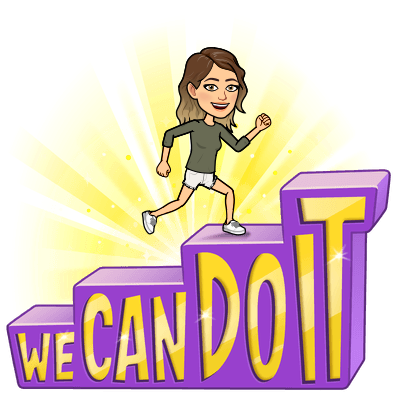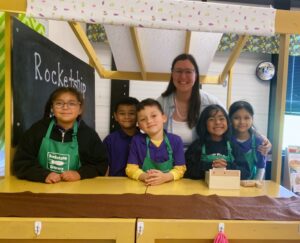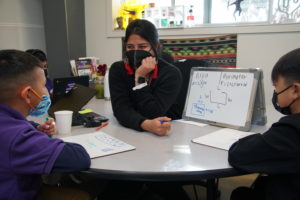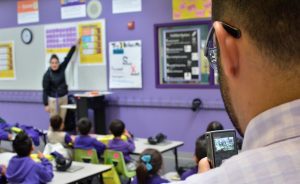
20 Ways to Better Support Students with Exceptionalities when Virtual Teaching
By Krista Pupillo, Integrated Special Education teacher, Nashville
Virtual learning has been an exciting, challenging, and sometimes frustrating new frontier for students and educators. While we’ve all masterfully risen to the challenge, the needs of students receiving special education services are top of mind for teachers trying their best to reach all students.
My defining philosophy as a teacher is “All students want to succeed, and all students can succeed.” I wholeheartedly believe that when provided the right tools, teachers can give each student what they need to be deeply engaged and invested in their learning, no matter how different their classroom looks this year.
As an integrated special education specialist, I collaborate closely with general education teachers to provide accommodations to students with diverse needs without lowering the expectations of what they can accomplish. I’ve compiled the most common questions I’ve received from teachers during virtual teaching and my advice for how other educators can support students with diverse needs in the virtual classrooms. (If you missed my webinar on this topic, download the resource sheet here.)
Q: My student isn’t completing their work on different platforms. It’s too difficult for them to do independently. How can I get them to do their work?
All students want to be successful in their classes, but when work is beyond their independent level of ability, it can lead to frustration and shutdown. Frustrated students may discontinue or refuse to continue work as a protective strategy against anxiety.
We can be proactive towards minimizing this frustration by determining which skills are most important to complete an assignment, and deciding which underdeveloped skill may impact a student’s ability to complete a task. For instance, If you assign a task to determine reading comprehension, but your student is developing their ability to write a complete sentence, a written response may not be the best choice. Instead, you can let them draw a picture, record an oral or video response, or use a multiple-choice option to allow them to demonstrate the skill!
Here are some other accommodation options that can be used:
Provide directions in multiple formats: Use pictures, verbal, and video instructions to demonstrate what you are expecting their work to look like.
Multiple modes of response: Allow students to draw, write, orally respond, or video their response to questions unless the task is specifically meant to practice writing.
Provide access to the text: For reading comprehension tasks, record a video of you reading the book or passage or screenshots of the texts to allow them to refer back to the text and find evidence to support their answers.
Read aloud questions: When assigning a worksheet, provide an audio recording of yourself reading the questions to the student.
Repetitive assignment format: When possible, maintain a consistent format in your assignments to allow the student to recognize what is expected of them and build confidence in their skills, even as the content changes.
Annotation: SeeSaw and other platforms provide annotation tools such as highlighters, drawings, and typing. Model for students how to use these different tools to find important information within the assignment. For younger grades, this may mean highlighting sight words or words with a specific phonics pattern. For upper grades, this may mean highlighting significant dates or other important details.
Guided work-time: Allow work-time within synchronous classes to allow students opportunities to ask questions and provide feedback on their work.
 Q: What are some different ways I can make their writing assignments more accessible over virtual platforms?
Q: What are some different ways I can make their writing assignments more accessible over virtual platforms?
The first thing to remember is that drawing or typing on a computer is a different skill than writing on paper, and can be especially difficult for students receiving occupational therapy services, who may encounter fine motor fatigue from trying to hold down the trackpad and draw. For other students, it may be beneficial to support their writing with scaffolds.
Here are some different ways to support writing in a virtual setting:
Encourage them to take pictures of their work: Allow students to write on paper or whiteboards, then upload an image of their work which will let them practice their writing in a more authentic manner than on screen.
Use Word banks and sentence frames: Providing scaffolds to reference within the assignment is a strong way to differentiate lessons to the independent skill level of each student.
Use Click and drag for tests: Instead of having the student write or type each word or letter, create click-and-drag opportunities that allow the student to place the correct answer in the right space, or arrange their spelling words in the correct order.
Q: How can I make math more accessible over virtual platforms?
The best part of math is how the content can be applied to the environment of the student, and how visual representations can be implemented in each lesson!
Use Visuals, visuals, visuals: On SeeSaw, stickers are available of base ten blocks for students to use to represent their numbers. Allowing students visuals to manipulate as they build their numbers can reinforce their number competency and better understand how numbers are composed and decomposed
Get Creative with Manipulatives: Lead students to create their own manipulatives at home to use for their learning. A piece of paper cut into strips and squares can be used as base-ten rods and units for students who benefit from hands-on materials to support their learning as they follow along on the screen.
Try Graphic organizers: Provide ten frames, number lines, and chunked strategy maps to allow students to work through multi-step math problems in the correct order.
Anchor charts: Attaching an anchor chart to your assignment allows your student to reference what they have learned in class and apply it to their current assignment.
 Q: My student is struggling to stay on-task online and it is difficult to redirect them virtually. How can I support their behavior needs in a distant setting?
Q: My student is struggling to stay on-task online and it is difficult to redirect them virtually. How can I support their behavior needs in a distant setting?
Many students receive Individualized Education Program (IEP) instruction and goals directly related to on-task behavior. Students are struggling in the transition to virtual learning, where they are being asked to remain seated for long periods of time and to ignore the distractions around them within their own homes, such as conversations with families, toys, and pets.
While it is important to acknowledge that, as virtual teachers, we are a guest in their homes, there are some ways to increase engagement and focus on their learning!
Create Visual agendas and checklists: Students work best when they know what to expect throughout their day, and how long they will be working on each task. Providing an agenda or expectations check at the beginning of class and referring back throughout the lesson helps them to frame their thinking about work time versus break time.
Incorporate Timers: Provide set amounts of time for work to increase engagement and to provide students with a better expectation of how long they should stay focused on their work.
Check-In/Check-out: Starting and ending each class period with a quick 5-minute check-in within a break-out room with your student will create an opportunity to go over expectations and develop collaborative goals for your class period. It will also give you a better sense of how your student is entering your space, and the energy and emotions they are feeling. Ask your student to join the Zoom five minutes early to allow time to check-in. This is a great opportunity to build your relationship with that student!
Utilize Self-Assessment Checklists: For older students, provide a self-assessment checklist for the student to complete after a task or class period. An easy Google Form with questions such as “Did I focus on the speaker?” will let them internalize their behavior and make goals to accomplish for the next period. Make sure to provide an opportunity to review the assessments with your student to discuss what they saw from their own behavior.
Encourage movement breaks: Incorporate movement into your lessons through whole body teaching, and allow students opportunities to take movement breaks throughout the lesson. When students are physically engaged, they are able to expend their kinesthetic energy and refocus on their lessons. Make sure to provide a timer or countdown when it is time to return to their learning space to reinforce the expectations.
Provide incentives: Providing incentives gives students a tangible goal to work for and to assess their behavior. In our school, our students are highly invested in ClassDojo points and take pride in each point earned. Other incentives can be stickers added to your Google Slides or in a goal chart on their SeeSaw or ClassDojo portfolio. Rewards for meeting their goals can be as simple as an extra GoNoodle break, virtual lunch with the teacher, or drawing time at the end of class. An important reminder is that the best incentives are always based on relationship building!
Even as our learning environment looks different, one thing remains the same – students with diverse needs deserve the opportunity to learn to their fullest potential and, when given the correct tools and support, can continue their growth as deeply engaged and highly capable learners.
Published on December 16, 2020
Read more stories about: Personalized Learning.
In the Classroom
How to Foster a Growth Mindset in the Classroom
Jeremiah Davis, Paraprofessional, Rocketship Dream Community Prep | April 10, 2025
Learn how to cultivate reflection, embrace challenges, and promote perseverance in yourself and in your students.
Read more ⟩How to Improve School Culture
Jeremiah Davis, Paraprofessional, Rocketship Dream Community Prep | March 3, 2025
Ready to ramp up moral at your school? Weave these nine celebrations into your school year!
Read more ⟩How Coaching in Schools Improves Outcomes
Rockesthip Public Schools | Feb 4, 2025
Learn how live coaching and weekly feedback sessions can help your teachers feel more supported year round!
Read more ⟩Parent Conference Tips for First Year Teachers
Jeremiah Davis, Paraprofessional, Rocketship Dream Community Prep | January 6, 2025
Looking for top parent conference tips? Prepare with advice from our educators.
Read more ⟩First Year Teacher? Here are Five Mistakes to Avoid.
Jeremiah Davis, Paraprofessional, Rocketship Dream Community Prep | November 1, 2024
See what mistakes most first year teachers make and how you can get ahead this school year with some simple tips from a fellow educator.
Read more ⟩3 Classroom Systems New Teachers Swear By
Rocketship Public Schools | Sept. 30, 2024
As a first year teacher, establishing a smooth and productive classroom environment can feel a tad overwhelming. Thankfully, these simple strategies can go a long way.
Read more ⟩How Co-Teacher Collaboration Can Benefit Your Classroom
Featuring Alejandra Chavez, Education Specialist at Rocketship Mosaic Elementary | June 10, 2024
Hear from Ms. Aly about how a small team of educators can make a big difference in student outcomes through thoughtful planning, focused collaboration, and personalized accommodations. Ms. Aly was one of our highest-performing educators in California for the 23-24 school year.
Read more ⟩How to Spark Joy in ESL Classrooms with a Multilingual Learning Clubhouse
Featuring Ms. Amy De La Rosa, Multilingual Specialist, Nashville Northeast Elementary | June 1, 2023
Listen in to an audio interview with Amy De La Rosa, a Multilingual Specialist who has worked as an educator for over 14 years and found an innovative way to help her students learn English in a more accelerated, playful way.
Read more ⟩Supporting Parents of Multilingual Students in Family/Teacher Conferences
Emma Volpe, Rocketship United Academy | June 1, 2022
Get thoughtful insight on how to create a more inclusive family-teacher conference environment.
Read more ⟩5 Ways to Strengthen Relationships in the Classroom
James Cross, Assistant Principal, Rocketship Nashville Northeast Elementary | February 20, 2022
A new age of education calls for a new level of connection. Here are some key tips to strengthen relationships in your classroom this school year.
Read more ⟩5 Ways School Leaders Can Coach and Support Teachers
Eesir Kaur, Director of Professional Development | October 15, 2020
Are you a school leader looking to coach your teachers more effectively? Here's what works for us.
Read more ⟩














